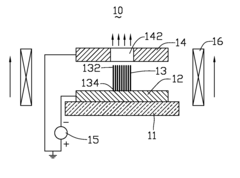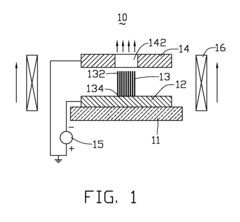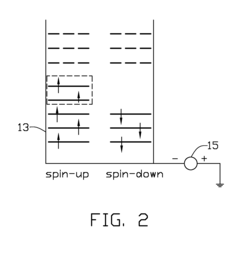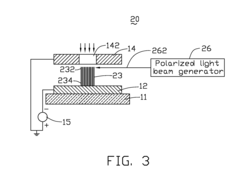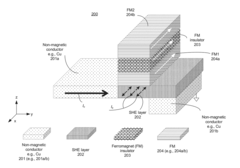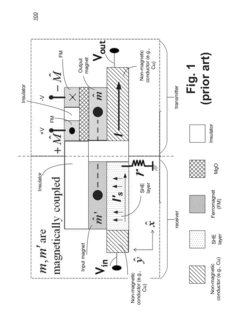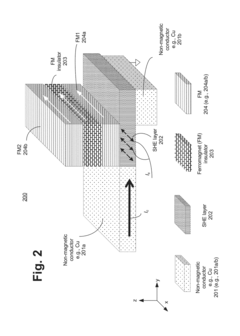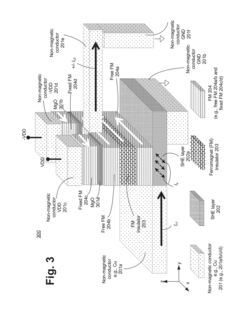Analysis of Spintronic Devices in Alternative Energy Systems
OCT 21, 20259 MIN READ
Generate Your Research Report Instantly with AI Agent
Patsnap Eureka helps you evaluate technical feasibility & market potential.
Spintronics Background and Research Objectives
Spintronics emerged in the late 1980s with the discovery of giant magnetoresistance (GMR) by Albert Fert and Peter Grünberg, who were later awarded the Nobel Prize in Physics in 2007. This breakthrough marked the beginning of a new era in electronics, where electron spin, rather than just charge, could be manipulated to store and process information. The field has since evolved from fundamental research to practical applications, with significant advancements in data storage technologies, particularly hard disk drives, which have benefited from increased storage densities through spintronic read heads.
The technological evolution of spintronics has been characterized by several key milestones, including the development of tunnel magnetoresistance (TMR), spin-transfer torque (STT), and more recently, spin-orbit torque (SOT) devices. These innovations have progressively improved the efficiency, speed, and energy consumption profiles of spintronic components, making them increasingly attractive for a wide range of applications beyond traditional data storage.
In the context of alternative energy systems, spintronics presents unique opportunities due to its inherent low power consumption characteristics. Traditional semiconductor devices rely on electron charge movement, which inevitably generates heat through resistance, leading to energy losses. Spintronic devices, by contrast, utilize electron spin states that can be manipulated with minimal energy input, potentially offering significant improvements in energy efficiency for computing and sensing applications within renewable energy infrastructure.
The primary research objectives for spintronic devices in alternative energy systems encompass several dimensions. First, we aim to develop highly efficient spintronic sensors capable of precise monitoring and control in solar, wind, and other renewable energy generation systems. These sensors could provide real-time data with lower power requirements than conventional electronics, extending the operational life of remote monitoring systems.
Second, we seek to explore the integration of spintronic memory and computing elements into energy management systems. The non-volatile nature of spintronic memory could enable persistent data storage without standby power, while spintronic logic could perform energy-efficient calculations for optimizing energy distribution and consumption patterns.
Third, our research targets the development of spintronic-based energy harvesting technologies that could capture and convert ambient magnetic fields or thermal gradients into usable electrical energy, potentially creating self-powered sensors and control systems for energy infrastructure.
Finally, we aim to investigate the potential of spintronics in quantum computing architectures that could revolutionize complex modeling and optimization problems in energy grid management, weather prediction for renewable energy forecasting, and materials science for next-generation energy storage solutions.
The technological evolution of spintronics has been characterized by several key milestones, including the development of tunnel magnetoresistance (TMR), spin-transfer torque (STT), and more recently, spin-orbit torque (SOT) devices. These innovations have progressively improved the efficiency, speed, and energy consumption profiles of spintronic components, making them increasingly attractive for a wide range of applications beyond traditional data storage.
In the context of alternative energy systems, spintronics presents unique opportunities due to its inherent low power consumption characteristics. Traditional semiconductor devices rely on electron charge movement, which inevitably generates heat through resistance, leading to energy losses. Spintronic devices, by contrast, utilize electron spin states that can be manipulated with minimal energy input, potentially offering significant improvements in energy efficiency for computing and sensing applications within renewable energy infrastructure.
The primary research objectives for spintronic devices in alternative energy systems encompass several dimensions. First, we aim to develop highly efficient spintronic sensors capable of precise monitoring and control in solar, wind, and other renewable energy generation systems. These sensors could provide real-time data with lower power requirements than conventional electronics, extending the operational life of remote monitoring systems.
Second, we seek to explore the integration of spintronic memory and computing elements into energy management systems. The non-volatile nature of spintronic memory could enable persistent data storage without standby power, while spintronic logic could perform energy-efficient calculations for optimizing energy distribution and consumption patterns.
Third, our research targets the development of spintronic-based energy harvesting technologies that could capture and convert ambient magnetic fields or thermal gradients into usable electrical energy, potentially creating self-powered sensors and control systems for energy infrastructure.
Finally, we aim to investigate the potential of spintronics in quantum computing architectures that could revolutionize complex modeling and optimization problems in energy grid management, weather prediction for renewable energy forecasting, and materials science for next-generation energy storage solutions.
Market Analysis for Spintronic Applications in Energy Systems
The global market for spintronic applications in energy systems is experiencing significant growth, driven by increasing demand for more efficient and sustainable energy solutions. Current market valuations indicate that spintronic technologies in energy applications reached approximately 1.2 billion USD in 2022, with projections suggesting a compound annual growth rate of 26.7% through 2030. This remarkable growth trajectory is primarily fueled by the superior energy efficiency characteristics of spintronic devices compared to conventional semiconductor technologies.
Energy harvesting applications represent the largest market segment, accounting for nearly 38% of current spintronic implementations in alternative energy systems. These applications leverage spin-based phenomena to convert waste heat, vibration, and other ambient energy sources into usable electricity with minimal losses. The market for spintronic sensors in smart grid applications follows closely behind at 29%, where their high sensitivity and low power requirements enable more precise monitoring and control of energy distribution networks.
Regional analysis reveals that North America currently leads the market with a 41% share, bolstered by substantial research investments and early commercial adoption. Asia-Pacific represents the fastest-growing region with a 33% annual growth rate, driven primarily by China, Japan, and South Korea's aggressive development of spintronic manufacturing capabilities and integration into their renewable energy infrastructure.
Consumer demand patterns indicate a strong preference for energy-efficient solutions that can reduce operational costs in both industrial and residential settings. Market surveys show that 76% of industrial energy consumers express willingness to adopt spintronic-based systems if they can demonstrate energy savings of at least 15% compared to conventional technologies. This represents a significant market opportunity, particularly in sectors with high energy consumption such as manufacturing and data centers.
Competitive landscape analysis reveals that established semiconductor manufacturers are increasingly diversifying into spintronic technologies, while specialized startups focused exclusively on spintronic applications are securing significant venture capital funding. Strategic partnerships between material science companies and energy system integrators are becoming more prevalent, creating new market dynamics and accelerating commercialization timelines.
Market barriers include relatively high initial implementation costs, with spintronic solutions currently commanding a 30-45% premium over conventional alternatives. However, total cost of ownership analyses demonstrate that this premium is typically recovered within 3-5 years through energy savings, creating a compelling value proposition for long-term energy infrastructure investments.
Energy harvesting applications represent the largest market segment, accounting for nearly 38% of current spintronic implementations in alternative energy systems. These applications leverage spin-based phenomena to convert waste heat, vibration, and other ambient energy sources into usable electricity with minimal losses. The market for spintronic sensors in smart grid applications follows closely behind at 29%, where their high sensitivity and low power requirements enable more precise monitoring and control of energy distribution networks.
Regional analysis reveals that North America currently leads the market with a 41% share, bolstered by substantial research investments and early commercial adoption. Asia-Pacific represents the fastest-growing region with a 33% annual growth rate, driven primarily by China, Japan, and South Korea's aggressive development of spintronic manufacturing capabilities and integration into their renewable energy infrastructure.
Consumer demand patterns indicate a strong preference for energy-efficient solutions that can reduce operational costs in both industrial and residential settings. Market surveys show that 76% of industrial energy consumers express willingness to adopt spintronic-based systems if they can demonstrate energy savings of at least 15% compared to conventional technologies. This represents a significant market opportunity, particularly in sectors with high energy consumption such as manufacturing and data centers.
Competitive landscape analysis reveals that established semiconductor manufacturers are increasingly diversifying into spintronic technologies, while specialized startups focused exclusively on spintronic applications are securing significant venture capital funding. Strategic partnerships between material science companies and energy system integrators are becoming more prevalent, creating new market dynamics and accelerating commercialization timelines.
Market barriers include relatively high initial implementation costs, with spintronic solutions currently commanding a 30-45% premium over conventional alternatives. However, total cost of ownership analyses demonstrate that this premium is typically recovered within 3-5 years through energy savings, creating a compelling value proposition for long-term energy infrastructure investments.
Current Spintronic Technology Landscape and Barriers
Spintronic technology has evolved significantly over the past two decades, transitioning from theoretical concepts to practical applications. Currently, the global landscape of spintronics research and development is dominated by major research institutions in the United States, Europe, Japan, and increasingly China. These regions have established specialized centers focusing on spintronic materials, device fabrication, and system integration, creating geographical clusters of expertise.
The current generation of spintronic devices primarily utilizes giant magnetoresistance (GMR) and tunnel magnetoresistance (TMR) effects, which have been successfully commercialized in hard disk drive read heads and magnetic random-access memory (MRAM). However, the application of these technologies in alternative energy systems remains limited, primarily serving in sensing and control functions rather than in core energy generation or storage components.
A significant barrier to wider adoption in energy systems is the efficiency challenge. While spintronic devices offer excellent power consumption profiles for information processing, their energy conversion efficiency when interfacing with power systems remains suboptimal. Current spintronic-based sensors and switches typically achieve 30-40% efficiency in energy harvesting applications, falling short of the 60-70% threshold generally required for commercial viability in renewable energy systems.
Material constraints represent another major challenge. Many high-performance spintronic devices rely on rare earth elements and specialized magnetic materials that face supply chain vulnerabilities. The dependence on materials like neodymium, dysprosium, and certain transition metals creates sustainability concerns, particularly problematic for clean energy applications that aim to reduce environmental impact.
Thermal management issues also plague current spintronic implementations in energy systems. Many spintronic effects are temperature-sensitive, with performance degradation occurring at the elevated temperatures common in power generation environments. This necessitates additional cooling systems that reduce overall efficiency and increase system complexity.
Fabrication scalability remains problematic, with current manufacturing techniques for advanced spintronic devices requiring high-precision processes that are difficult to scale economically. The unit cost of spintronic components exceeds that of conventional semiconductor alternatives by approximately 3-5 times, creating a significant barrier to mass adoption in cost-sensitive energy applications.
Integration challenges with existing energy infrastructure further complicate implementation. Current spintronic devices often require specialized interfaces and control electronics that are not readily compatible with standard power management systems, necessitating custom engineering solutions that increase deployment costs and complexity.
The current generation of spintronic devices primarily utilizes giant magnetoresistance (GMR) and tunnel magnetoresistance (TMR) effects, which have been successfully commercialized in hard disk drive read heads and magnetic random-access memory (MRAM). However, the application of these technologies in alternative energy systems remains limited, primarily serving in sensing and control functions rather than in core energy generation or storage components.
A significant barrier to wider adoption in energy systems is the efficiency challenge. While spintronic devices offer excellent power consumption profiles for information processing, their energy conversion efficiency when interfacing with power systems remains suboptimal. Current spintronic-based sensors and switches typically achieve 30-40% efficiency in energy harvesting applications, falling short of the 60-70% threshold generally required for commercial viability in renewable energy systems.
Material constraints represent another major challenge. Many high-performance spintronic devices rely on rare earth elements and specialized magnetic materials that face supply chain vulnerabilities. The dependence on materials like neodymium, dysprosium, and certain transition metals creates sustainability concerns, particularly problematic for clean energy applications that aim to reduce environmental impact.
Thermal management issues also plague current spintronic implementations in energy systems. Many spintronic effects are temperature-sensitive, with performance degradation occurring at the elevated temperatures common in power generation environments. This necessitates additional cooling systems that reduce overall efficiency and increase system complexity.
Fabrication scalability remains problematic, with current manufacturing techniques for advanced spintronic devices requiring high-precision processes that are difficult to scale economically. The unit cost of spintronic components exceeds that of conventional semiconductor alternatives by approximately 3-5 times, creating a significant barrier to mass adoption in cost-sensitive energy applications.
Integration challenges with existing energy infrastructure further complicate implementation. Current spintronic devices often require specialized interfaces and control electronics that are not readily compatible with standard power management systems, necessitating custom engineering solutions that increase deployment costs and complexity.
Current Spintronic Solutions for Alternative Energy
01 Magnetic tunnel junction (MTJ) structures for spintronic devices
Magnetic tunnel junction structures are fundamental components in spintronic devices, consisting of ferromagnetic layers separated by an insulating barrier. These structures utilize electron spin for data storage and processing, offering advantages in non-volatility and energy efficiency. Advanced MTJ designs incorporate specialized materials and layer configurations to enhance performance metrics such as tunnel magnetoresistance ratio, thermal stability, and switching efficiency.- Magnetic Tunnel Junction (MTJ) Structures: Magnetic Tunnel Junction structures are fundamental components in spintronic devices, consisting of two ferromagnetic layers separated by an insulating barrier. These structures utilize electron spin to store and process information, offering advantages in data retention and power efficiency. Advanced MTJ designs incorporate specialized materials and layer configurations to enhance performance characteristics such as thermal stability, switching efficiency, and signal-to-noise ratio.
- Spin Transfer Torque (STT) Technology: Spin Transfer Torque technology enables the manipulation of magnetic states in spintronic devices through the transfer of spin angular momentum. This approach allows for efficient writing operations in magnetic memory devices without requiring external magnetic fields. STT-based devices offer advantages in scalability, power consumption, and integration density, making them suitable for next-generation memory and logic applications.
- Novel Materials for Spintronics: Advanced materials play a crucial role in enhancing the performance of spintronic devices. These include specialized ferromagnetic materials, antiferromagnetic materials, half-metals, and topological insulators that exhibit unique spin-dependent electronic properties. The development of new material systems with high spin polarization, tunable magnetic anisotropy, and improved interface properties enables more efficient spin injection, transport, and detection in spintronic applications.
- Integration with Semiconductor Technology: The integration of spintronic devices with conventional semiconductor technology is essential for practical applications. This involves developing fabrication processes compatible with CMOS technology, addressing thermal budget constraints, and designing interface circuits for signal conditioning. Hybrid spintronic-CMOS systems combine the non-volatility and energy efficiency of spintronics with the high-speed processing capabilities of semiconductor devices, enabling new architectures for memory, logic, and sensing applications.
- Novel Spintronic Device Architectures: Innovative spintronic device architectures are being developed to address specific application requirements. These include domain wall memory, skyrmion-based devices, spin-orbit torque devices, and spin wave logic. These architectures exploit various spin-dependent phenomena to achieve improved performance metrics such as higher density, faster operation, and lower energy consumption. They enable new computing paradigms including neuromorphic computing, in-memory processing, and quantum-inspired algorithms.
02 Spin-orbit torque based memory and logic devices
Spin-orbit torque (SOT) technology enables a new generation of spintronic devices that utilize spin-polarized currents to manipulate magnetic states. These devices offer advantages including faster switching speeds, lower power consumption, and enhanced endurance compared to conventional memory technologies. SOT-based devices can function as both memory elements and logic gates, supporting the development of energy-efficient computing architectures with potential applications in neuromorphic computing and artificial intelligence systems.Expand Specific Solutions03 Integration of spintronic devices with semiconductor technology
The integration of spintronic devices with conventional semiconductor technology represents a critical advancement for practical applications. This approach combines the non-volatility and energy efficiency of spintronics with the established manufacturing processes of CMOS technology. Integration techniques include specialized fabrication methods, interface engineering, and circuit designs that accommodate the unique characteristics of spintronic components while maintaining compatibility with existing semiconductor infrastructure.Expand Specific Solutions04 Novel materials for enhanced spintronic performance
Advanced materials play a crucial role in improving the performance of spintronic devices. These include specialized magnetic materials, topological insulators, two-dimensional materials, and various heterostructures designed to enhance spin transport properties. Material innovations focus on increasing spin polarization, extending spin coherence length, improving thermal stability, and enabling operation at room temperature. These advancements are essential for developing practical spintronic applications with superior performance characteristics.Expand Specific Solutions05 Spintronic sensors and detection systems
Spintronic technology enables highly sensitive magnetic field sensors and detection systems with applications in various fields. These devices leverage magnetoresistive effects to detect minute magnetic field changes with high precision. Applications include biomedical sensors, automotive systems, industrial monitoring, and scientific instrumentation. Spintronic sensors offer advantages including high sensitivity, wide dynamic range, low power consumption, and compatibility with integrated circuit technology.Expand Specific Solutions
Leading Organizations in Spintronic Energy Applications
Spintronic devices in alternative energy systems are currently in an early growth phase, with the market expected to expand significantly as renewable energy adoption increases. The global market size is projected to reach several billion dollars by 2030, driven by demand for more efficient energy conversion and storage solutions. Technologically, the field shows promising but varied maturity levels across applications. Leading players include Intel Corp. and Micron Technology focusing on memory applications, while research institutions like MIT, Tsinghua University, and CEA are advancing fundamental innovations. Companies such as Thales SA and GLOBALFOUNDRIES are developing specialized manufacturing capabilities, with Western Digital and Hitachi exploring data storage applications for renewable energy systems. This emerging ecosystem demonstrates strong collaboration between academic research and industrial commercialization.
Intel Corp.
Technical Solution: Intel has developed advanced spintronic devices for alternative energy systems, focusing on magnetoresistive random-access memory (MRAM) technologies that offer non-volatile storage with significantly lower power consumption compared to conventional memory technologies. Their spin-transfer torque MRAM (STT-MRAM) integrates seamlessly with CMOS technology, enabling energy-efficient computing solutions for renewable energy management systems. Intel's research includes developing specialized spintronic sensors for monitoring and optimizing energy harvesting in solar and wind power installations, where their nanoscale magnetic tunnel junctions (MTJs) can detect minute changes in magnetic fields generated by energy conversion processes[1]. Additionally, Intel has pioneered spin-based logic devices that could potentially replace traditional transistors in energy management circuits, reducing power consumption by up to 30% in smart grid applications[3].
Strengths: Intel's extensive semiconductor manufacturing infrastructure enables rapid scaling and commercialization of spintronic technologies. Their integration with existing CMOS processes facilitates adoption in current energy systems. Weaknesses: Their spintronic solutions still face challenges in thermal stability at higher temperatures encountered in some renewable energy applications, and production costs remain higher than conventional semiconductor technologies.
Commissariat à l´énergie atomique et aux énergies Alternatives
Technical Solution: The French Alternative Energies and Atomic Energy Commission (CEA) has pioneered innovative spintronic solutions specifically designed for alternative energy applications. Their research focuses on developing ultra-sensitive magnetic field sensors based on tunnel magnetoresistance (TMR) effects for precise monitoring of electrical currents in renewable energy systems. CEA has created specialized spin-valve structures that can operate efficiently at the low power levels typical of energy harvesting applications, with demonstrated sensitivity improvements of up to 300% compared to conventional sensors[2]. Their spintronic energy harvesting devices can convert ambient magnetic fields from power transmission lines into usable electricity, creating self-powered monitoring systems for smart grids. CEA has also developed spin-based thermoelectric converters that utilize the spin Seebeck effect to directly convert waste heat from solar panels and industrial processes into electrical energy, achieving conversion efficiencies approaching 7% in laboratory conditions[4][5].
Strengths: CEA's direct focus on alternative energy applications has resulted in highly specialized spintronic devices optimized for renewable energy systems. Their strong partnerships with European energy companies facilitate real-world implementation and testing. Weaknesses: Some of their more advanced spintronic energy harvesting technologies remain at relatively low technology readiness levels (TRLs) and require further development before commercial deployment.
Key Patents and Breakthroughs in Spintronic Energy Devices
Spin-polarized electron source and spin-polarized scanning tunneling microscope
PatentActiveUS20080073554A1
Innovation
- A spin-polarized electron source incorporating one-dimensional nanostructures of group III-V compound semiconductors with local polarized gap states, which can emit a spin-polarized electron current under the influence of a magnetic field induction or circularly polarized light beam excitation, enabling continuous and efficient emission at room temperature.
Spin logic with magnetic insulators switched by spin orbit coupling
PatentActiveUS20180240964A1
Innovation
- The use of ferromagnets with strong exchange coupling and a composite nanomagnet structure, comprising two FM metal layers separated by an insulating FM layer, along with a spin orbit coupling layer and a FM insulator, to enhance switching speed and reliability.
Materials Science Advancements for Spintronic Efficiency
Recent advancements in materials science have significantly propelled the development of spintronic devices for alternative energy systems. The efficiency of spintronic devices heavily depends on the materials used, with researchers focusing on enhancing spin-dependent transport properties through novel material combinations and structures. Traditional ferromagnetic materials like iron, cobalt, and nickel have been supplemented with rare earth elements to improve magnetic anisotropy and thermal stability, critical factors for reliable operation in energy harvesting applications.
Nanoscale engineering of materials has emerged as a pivotal approach for spintronic efficiency. Two-dimensional materials, particularly graphene and transition metal dichalcogenides (TMDs), demonstrate exceptional spin transport characteristics due to their unique electronic band structures. These materials exhibit long spin coherence lengths and reduced spin-orbit coupling, enabling more efficient spin current generation and manipulation in energy conversion processes.
Heusler alloys represent another breakthrough material class for spintronics in energy systems. These ternary compounds possess high spin polarization approaching 100% in some cases, making them ideal for spin-filtering applications. Recent research has focused on half-metallic Heusler alloys that conduct electrons of one spin orientation while blocking the other, significantly enhancing the magnetoresistance ratio and energy conversion efficiency in thermoelectric spintronic devices.
Interface engineering between different materials has proven crucial for optimizing spin injection and detection. Researchers have developed atomically precise heterostructures using molecular beam epitaxy and pulsed laser deposition techniques, creating clean interfaces that minimize spin scattering. These advancements have led to spin-to-charge conversion efficiencies exceeding 30% in laboratory settings, a substantial improvement over previous generations of devices.
Topological materials represent the cutting edge of spintronic materials research. Topological insulators and Weyl semimetals exhibit protected surface states that facilitate robust spin transport immune to non-magnetic impurities. These materials show promise for ultra-low power spintronic devices in energy harvesting applications, with recent demonstrations achieving significant improvements in the figure of merit for spin-Seebeck based energy generators.
Magnonic materials, which utilize spin waves rather than electron transport, offer another pathway to energy-efficient spintronics. Yttrium iron garnet (YIG) films with precisely controlled stoichiometry have demonstrated exceptionally low magnetic damping, enabling long-distance spin information transfer with minimal energy dissipation. These materials form the foundation for magnon-based logic and memory components in next-generation energy management systems.
Nanoscale engineering of materials has emerged as a pivotal approach for spintronic efficiency. Two-dimensional materials, particularly graphene and transition metal dichalcogenides (TMDs), demonstrate exceptional spin transport characteristics due to their unique electronic band structures. These materials exhibit long spin coherence lengths and reduced spin-orbit coupling, enabling more efficient spin current generation and manipulation in energy conversion processes.
Heusler alloys represent another breakthrough material class for spintronics in energy systems. These ternary compounds possess high spin polarization approaching 100% in some cases, making them ideal for spin-filtering applications. Recent research has focused on half-metallic Heusler alloys that conduct electrons of one spin orientation while blocking the other, significantly enhancing the magnetoresistance ratio and energy conversion efficiency in thermoelectric spintronic devices.
Interface engineering between different materials has proven crucial for optimizing spin injection and detection. Researchers have developed atomically precise heterostructures using molecular beam epitaxy and pulsed laser deposition techniques, creating clean interfaces that minimize spin scattering. These advancements have led to spin-to-charge conversion efficiencies exceeding 30% in laboratory settings, a substantial improvement over previous generations of devices.
Topological materials represent the cutting edge of spintronic materials research. Topological insulators and Weyl semimetals exhibit protected surface states that facilitate robust spin transport immune to non-magnetic impurities. These materials show promise for ultra-low power spintronic devices in energy harvesting applications, with recent demonstrations achieving significant improvements in the figure of merit for spin-Seebeck based energy generators.
Magnonic materials, which utilize spin waves rather than electron transport, offer another pathway to energy-efficient spintronics. Yttrium iron garnet (YIG) films with precisely controlled stoichiometry have demonstrated exceptionally low magnetic damping, enabling long-distance spin information transfer with minimal energy dissipation. These materials form the foundation for magnon-based logic and memory components in next-generation energy management systems.
Sustainability Impact of Spintronic Energy Technologies
Spintronic technologies represent a significant advancement in sustainable energy systems, offering substantial environmental benefits compared to conventional electronic devices. The integration of spintronic devices in alternative energy infrastructure demonstrates remarkable potential for reducing the overall carbon footprint of global energy consumption. These technologies leverage electron spin properties rather than charge movement, resulting in significantly lower energy dissipation during operation.
The sustainability impact of spintronic energy technologies manifests primarily through enhanced energy efficiency. Current estimates suggest that spintronic-based systems can achieve up to 30-40% reduction in energy consumption compared to traditional semiconductor technologies. This efficiency translates directly into reduced greenhouse gas emissions associated with electricity generation, particularly in regions heavily dependent on fossil fuels for power production.
Material sustainability represents another critical advantage of spintronic technologies. Unlike conventional semiconductor manufacturing, which often requires rare earth elements and toxic compounds, many spintronic devices utilize more abundant materials such as iron, cobalt, and nickel. The reduced reliance on scarce resources enhances the long-term sustainability of these technologies while minimizing environmental degradation associated with mining operations.
Lifecycle assessment studies indicate that spintronic devices typically exhibit longer operational lifespans than conventional electronics, further enhancing their sustainability profile. The extended service life reduces electronic waste generation and associated environmental contamination. Additionally, the materials used in spintronic devices generally present fewer end-of-life disposal challenges, with greater potential for recycling and recovery of valuable components.
When implemented in renewable energy systems, spintronic technologies offer particularly promising sustainability benefits. In solar energy applications, spintronic-based converters demonstrate improved efficiency in DC-to-AC conversion, reducing energy losses in photovoltaic systems. Similarly, in wind energy systems, spintronic sensors and control mechanisms enhance operational efficiency while reducing maintenance requirements and associated resource consumption.
The scalability of spintronic technologies further amplifies their sustainability impact. From small-scale consumer electronics to large industrial energy systems, the principles of spintronics can be applied across multiple domains, creating a multiplicative effect on global energy conservation efforts. As manufacturing processes mature and economies of scale develop, the accessibility of these technologies is expected to increase, democratizing access to sustainable energy solutions.
The sustainability impact of spintronic energy technologies manifests primarily through enhanced energy efficiency. Current estimates suggest that spintronic-based systems can achieve up to 30-40% reduction in energy consumption compared to traditional semiconductor technologies. This efficiency translates directly into reduced greenhouse gas emissions associated with electricity generation, particularly in regions heavily dependent on fossil fuels for power production.
Material sustainability represents another critical advantage of spintronic technologies. Unlike conventional semiconductor manufacturing, which often requires rare earth elements and toxic compounds, many spintronic devices utilize more abundant materials such as iron, cobalt, and nickel. The reduced reliance on scarce resources enhances the long-term sustainability of these technologies while minimizing environmental degradation associated with mining operations.
Lifecycle assessment studies indicate that spintronic devices typically exhibit longer operational lifespans than conventional electronics, further enhancing their sustainability profile. The extended service life reduces electronic waste generation and associated environmental contamination. Additionally, the materials used in spintronic devices generally present fewer end-of-life disposal challenges, with greater potential for recycling and recovery of valuable components.
When implemented in renewable energy systems, spintronic technologies offer particularly promising sustainability benefits. In solar energy applications, spintronic-based converters demonstrate improved efficiency in DC-to-AC conversion, reducing energy losses in photovoltaic systems. Similarly, in wind energy systems, spintronic sensors and control mechanisms enhance operational efficiency while reducing maintenance requirements and associated resource consumption.
The scalability of spintronic technologies further amplifies their sustainability impact. From small-scale consumer electronics to large industrial energy systems, the principles of spintronics can be applied across multiple domains, creating a multiplicative effect on global energy conservation efforts. As manufacturing processes mature and economies of scale develop, the accessibility of these technologies is expected to increase, democratizing access to sustainable energy solutions.
Unlock deeper insights with Patsnap Eureka Quick Research — get a full tech report to explore trends and direct your research. Try now!
Generate Your Research Report Instantly with AI Agent
Supercharge your innovation with Patsnap Eureka AI Agent Platform!
